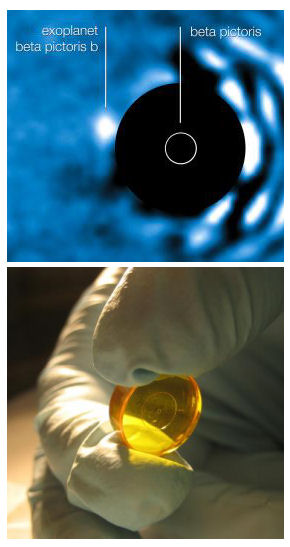18 October 2010
New optics capture exoplanet 63 million light years distant
by Kate Melville
 New optical technology has allowed an international team of astronomers to obtain images of the exoplanet known as Beta Pictoris b in the Beta Pictoris system, some 63 million light years away. The discovery, published in Astrophysical Journal Letters, is a result of an international collaboration involving the University of Arizona (UA), Steward Observatory, the Swiss Federal Institute of Technology Zurich, the European Southern Observatory, Leiden University in the Netherlands and Germany's Max-Planck-Institute for Astronomy.
New optical technology has allowed an international team of astronomers to obtain images of the exoplanet known as Beta Pictoris b in the Beta Pictoris system, some 63 million light years away. The discovery, published in Astrophysical Journal Letters, is a result of an international collaboration involving the University of Arizona (UA), Steward Observatory, the Swiss Federal Institute of Technology Zurich, the European Southern Observatory, Leiden University in the Netherlands and Germany's Max-Planck-Institute for Astronomy.
At the core of the system is a small piece of glass (pictured right - about the size of a cough drop) with a highly complex pattern inscribed into its surface. Called an Apodizing Phase Plate (APP), the device blocks out the starlight in a very defined way, allowing planets to show up in the image whose signals were previously drowned out by the star's glare.
"This technique opens new doors in planet discovery," said Phil Hinz, director of the UA's Center for Astronomical Adaptive Optics. "Until now, we only were able to look at the outer planets in a solar system, in the range of Neptune's orbit and beyond. Now we can see planets on orbits much closer to their parent star."
Hinz explained that if alien astronomers in another solar system were studying our solar system using the technology previously available for direct imaging detection, all they would see would be Uranus and Neptune. The inner planets, Mercury, Venus, Earth, Mars and Saturn, simply wouldn't show up in their telescope images.
The newly imaged planet orbits its star at about seven AUs (Astronomical Units - one AU is the distance between the Earth and the Sun), a distance where things get especially interesting, according to Hinz, "because that's where we believe the bulk of the planetary mass to be in most solar systems. Between five and 10 AUs."
Because of previous technical limitations, Hinz believes that the growing zoo of extrasolar planets discovered to date - mostly super-massive gas giants on wide orbits - represents a biased sample because their size and distance to their parent star makes them easier to detect. "You could say we started out by looking at oddball solar systems out there. The technique we developed allows us to search for lower-mass gas giants about the size of Jupiter, which are more representative of what is out there." Now, thanks to the APP, that may be about to change. "For the first time, we can search around bright, nearby stars such as Alpha Centauri, to see if they have gas giants."
The breakthrough, which may eventually allow observers to even block out starlight completely, was made possible through highly complex mathematical modeling. "Basically, we are canceling out the starlight halo that otherwise would drown out the light signal of the planet," said UA's Johanan Codona, who developed the theory behind the technique, which he calls phase-apodization coronagraphy. "If you're trying to find something that is thousands or a million times fainter than the star, dealing with the halo is a big challenge."
In order to block out glare from a star, conventional coronagraphs have to be precisely lined up and are highly susceptible to disturbance. A soft night breeze vibrating the telescope might be all it takes to ruin the image. The APP, on the other hand, requires no aiming and works equally well on any stars or locations in the image. "Our system doesn't care about those kinds of disturbances," Codona said. "It makes observing dramatically easier and much more efficient."
Related:
Newly discovered exoplanet may be habitable
Astronomers detect distant solar system with five planets
CO2 detected on distant extrasolar planet
Source: University of Arizona
